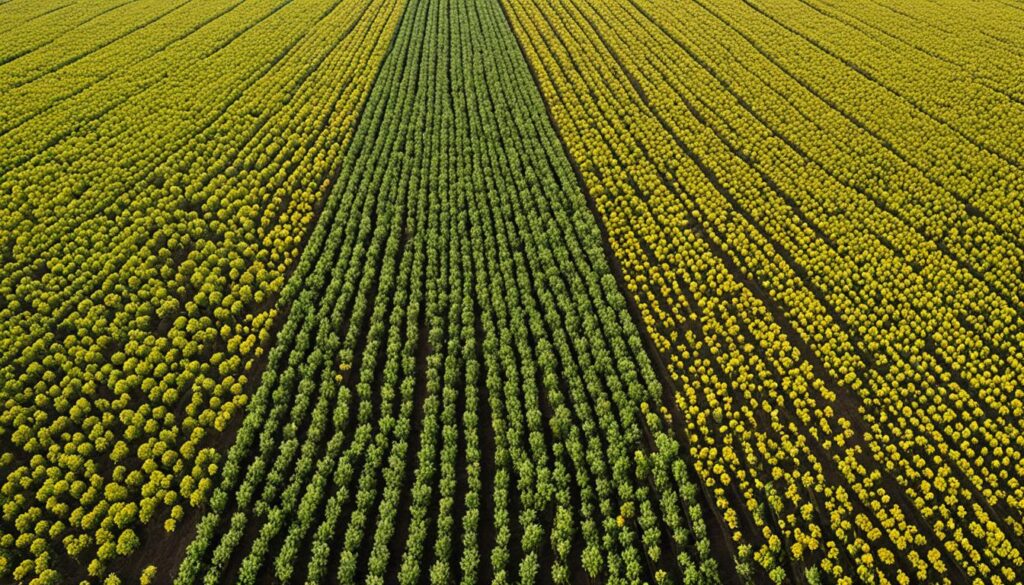Unseasonal weather patterns can have a profound impact on plant growth and pose unique challenges for gardeners. Mild weather, characterized by unseasonal temperatures, can disrupt the natural cycles of plant development and affect their overall health and productivity. It is crucial to understand the effects of these climatic changes to effectively manage and adapt gardening practices.
Key Takeaways:
- Mild weather events, such as false springs, can trick plants into premature bud development, leading to damage and hindered growth.
- Unseasonal climates can negatively impact plant health, reducing their ability to produce flowers and fruits.
- The timing of crop planting and yield can be disrupted by unseasonal climates, affecting agricultural productivity.
- Winter climate plays a vital role in the development of plant communities and ecosystem processes.
- Species-specific responses to winter disturbance contribute to the heterogeneity of plant communities.
The Impact of False Springs on Plant Health
False springs, caused by unseasonal climate patterns, have a negative impact on plant health. When plants experience a false spring, they are forced to use their stored resources to re-form lost leaf and flower buds. This can lead to a decline in overall plant health and a reduced ability to produce flowers and fruits.
False springs can also disrupt the timing of plant growth and the availability of essential nutrients, affecting the overall health and productivity of plants. As climate change continues to create unpredictable weather patterns, the occurrence of false springs may become more frequent, posing a greater risk to plant health.
To mitigate the effects of false springs, gardeners can employ various gardening strategies. One effective strategy is to provide mulch around the base of plants. Mulch helps regulate soil temperature and moisture, providing a protective layer for plants during fluctuating weather conditions. Another helpful strategy is to use support structures such as stakes or cages for plants that may be prone to damage from sudden temperature drops.
In addition, gardeners can promote overall plant resilience by maintaining a healthy garden environment. This includes regularly amending soil with organic matter to improve nutrient availability and water-holding capacity. Implementing proper watering practices, such as watering deeply but less frequently, can also help plants develop deep root systems that can better withstand temperature fluctuations.
By implementing these gardening strategies, gardeners can help plants adapt to the challenges posed by false springs and promote their overall health and productivity.
The Effects of Unseasonal Climates on Agriculture

Unseasonal climates, including false springs, can have significant impacts on agriculture. Changes in climate patterns can disrupt the timing of crop planting, flowering, and fruiting, leading to reduced crop yields. Extreme weather events, such as droughts and heatwaves, can further exacerbate these challenges and increase the risk of crop failure. Climate change models suggest that the frequency of extreme weather events may increase, posing even greater risks to agricultural productivity. To address these challenges, farmers need to implement adaptive strategies, such as selecting climate-resilient crop varieties, improving water management techniques, and implementing sustainable farming practices.
| Crop | Impact of Unseasonal Climates | Adaptive Strategies |
|---|---|---|
| Wheat | Delayed planting due to prolonged winter can reduce yield | Planting early-maturing varieties, adopting conservation tillage |
| Tomatoes | False springs can damage blossoms, resulting in reduced fruit set | Using row covers, providing frost protection, selecting cold-tolerant varieties |
| Corn | Drought and heatwaves can decrease pollination and kernel development | Implementing irrigation systems, intercropping, practicing soil conservation |
To mitigate the effects of unseasonal climates on agriculture, proactive measures are essential. Farmers must stay updated on climate forecasts and adapt their cultivation practices accordingly. By selecting crop varieties that are more resistant to extreme weather conditions, farmers can enhance their resilience to climate change. Implementing advanced water management techniques, such as drip irrigation and rainwater harvesting, can help conserve water resources and mitigate the impact of droughts. Additionally, implementing sustainable farming practices, such as organic farming and cover cropping, can enhance soil health and reduce vulnerability to climate-related challenges.
The Role of Winter Climate in Plant Community Development
While much attention has been given to the effects of summer climate on plant communities, the importance of winter climate is often overlooked. Winter climate, including factors such as snow cover and extreme weather events, plays a crucial role in the development of plant communities and various ecosystem processes.
Extreme winter warming events can have significant consequences for vegetation, particularly for dwarf shrubs and mosses. These vulnerable species can suffer damage and even mortality when exposed to sudden and prolonged periods of warmth during winter. Lichens, on the other hand, exhibit more variable responses to winter warming events.
Changes in snow cover and depth also have profound impacts on plant communities. Variations in snow accumulation can lead to spatial heterogeneity in plant growth, affecting the distribution and abundance of different species within a community. Furthermore, alterations in snow cover can influence carbon cycling in ecosystems and impact the interactions between plants and arthropod communities.
Understanding the effects of winter climate on plant communities is crucial for predicting and managing ecosystem responses to climate change. By recognizing the role of winter climate in shaping plant community composition and ecosystem processes, researchers and conservationists can develop effective strategies to mitigate the impacts of climate change on natural habitats.
Impacts of Winter Climate on Plant Communities:
- Extreme winter warming events can cause damage to vegetation, particularly dwarf shrubs and mosses.
- Lichens exhibit variable responses to winter warming events.
- Changes in snow cover and depth lead to spatial heterogeneity in plant growth.
- Altered snow cover impacts carbon cycling and arthropod communities.
Studies have shown that winter climate has a profound influence on plant community development. By considering the effects of winter climate on vegetation, we can gain valuable insights into how ecosystems respond to changing environmental conditions. This knowledge is crucial for informing conservation efforts and ensuring the long-term resilience of plant communities in the face of climate change.
Examples of Winter Climate Effects on Plant Communities
| Plant Species | Winter Climate Impact |
|---|---|
| Dwarf Shrubs | Damage and mortality during extreme winter warming events |
| Mosses | Susceptible to damage under prolonged periods of winter warmth |
| Lichens | Variable responses to winter warming events |
| Tree Saplings | Effects on growth and survival due to altered snow cover |
The Importance of Species-Specific Responses to Winter Disturbance
Species-specific responses to winter disturbance are crucial for maintaining vegetation heterogeneity in plant communities. In the face of winter climate change, some species may suffer damage, while others exhibit resilience or even employ compensatory growth strategies. Understanding these unique responses is vital for predicting and managing the diverse composition of plant communities in the wake of changing winter conditions.
Deciduous species, such as Vaccinium myrtillus, are particularly significant in the context of winter climate change. Changes in winter snow cover can have profound effects on their response and, in turn, influence community composition and ecosystem processes. To fully comprehend the impacts of winter climate change on different plant species and their interactions within ecosystems, further research is needed.
By investigating species-specific responses, scientists can develop a clearer understanding of the underlying mechanisms that drive vegetation heterogeneity during winter disturbance events. This knowledge is invaluable for effective conservation and management strategies aimed at mitigating the ecological consequences of winter climate change. By preserving the resilience of certain species and their unique adaptations, we can maintain the overall health and stability of plant communities in the face of an uncertain climate future.
FAQ
What are the effects of unseasonal climates on plant growth?
Unseasonal climates, such as mild weather and false springs, can have detrimental effects on plant growth. False springs, characterized by an early warming event followed by freezing temperatures, can cause plants to open their buds prematurely, only for them to be killed by subsequent freezing temperatures. This setback can hinder the plant’s ability to flower and fruit, leading to a decline in overall plant health.
How can gardeners mitigate the effects of false springs on plant health?
To mitigate the effects of false springs, gardeners can implement strategies such as providing mulch and support to help plants recover and adapt to changing climate conditions. Mulch can help protect the plants from extreme temperature fluctuations, while support structures can help them recover and continue their growth.
What impacts do unseasonal climates have on agriculture?
Unseasonal climates, including false springs, can have significant impacts on agriculture. Changes in climate patterns can disrupt the timing of crop planting, flowering, and fruiting, leading to reduced crop yields. Extreme weather events, such as droughts and heatwaves, can further exacerbate these challenges and increase the risk of crop failure.
How can farmers address the challenges posed by unseasonal climates?
To address the challenges posed by unseasonal climates, farmers can implement adaptive strategies such as selecting climate-resilient crop varieties, improving water management techniques, and implementing sustainable farming practices. These measures can help farmers mitigate the negative impacts of climate change on agricultural productivity.
What role does winter climate play in plant community development?
Winter climate, including changes in snow cover and extreme weather events, plays a crucial role in plant community development and ecosystem processes. Extreme winter warming events can cause damage to vegetation, while changes in snow cover and depth can lead to spatial heterogeneity in plant growth, carbon cycling, and arthropod communities.
Why are species-specific responses to winter disturbance important?
Species-specific responses to winter disturbance play a significant role in the heterogeneity of plant communities. Understanding these responses is crucial for predicting and managing vegetation heterogeneity in response to winter climate change. For example, the response of deciduous species, such as Vaccinium myrtillus, to changes in winter snow cover can have significant implications for community composition and ecosystem processes.

